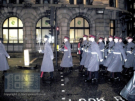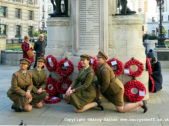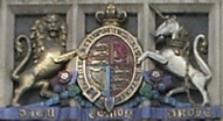





Docklands and the Thames,
Victoria Park to Paternoster
Square. Take a nostalgic
trip back to the East End in
the 1950’s or a stroll around
the Square Mile of the City
of London. It’s all here at
barryoneoff.co.uk
THE CEREMONIES and societies of the City
Copyright 2002 - 2024 ©Barry Carter. All rights reserved
Customs, ceremonies
and traditions
The City of London retains many of it’s old customs and ceremonies and hopefully they will not be allowed to disappear into oblivion in the City’s seemingly mad rush for modernisation. You can sometimes see a modern day coach driving down Moorgate into Gresham Street full of soldiers from centuries ago complete with pike staffs and breastplates on their way to a Guildhall ceremony. You may also see men in strange old fashioned garb of officialdom walking along the street on their way to an official duty. As far as I know the subjects below are still in existence at the time of writing. There are so many more ceremonies that I have found out about that it will take me some time to complete this section. I will try to attend and photograph as many as possible in the future.Wreath Laying Ceremony
Most of you will know about Remembrance Sunday wreath laying at the Cenotaph in Whitehall each year but very few will be aware of a much smaller ceremony in the City of London on the same day. It is the newly elected Lord Mayor's first public duty after the Lord Mayors Show. The London War Memorial is situated at the foot of the steps of the Royal Exchange and it is here that the wreath laying takes place. The Honourable Artillery Company march from Saint Paul’s Cathedral to the Exchange and wait there for the Lord Mayor to walk across the road from the Mansion House. The Lord Mayor and dignitaries lay their wreaths at the foot of the memorial and a small service is held. Forces veterans always form a large part of the crowd. Photo album >>The Spital Sermons
The word ‘Spital’ meant a place where the poor and afflicted are taken care of. The word ‘hospital’ is derived from it. The sermons were originally held in the open air at Saint Mary Spital in what is now Spitalfields, on Easter Monday, Tuesday, and Wednesday. The pulpit was destroyed in 1642, but after the revolution the sermons were held at Saint Brides Fleet Street and then Christ’s Church Newgate Street. After the later was destroyed during the war the venue was changed to Saint Lawrence Jewry in Gresham Street. It is attended by the Lord Mayor with his complete escort of Sword bearer, Common Crier, Sergeant at Arms, and City Marshall as well as Sheriffs and Aldermen. They walk to the church from the Aldermen’s Court Room near Guildhall Yard.The right to bear arms in
The City
The motto of the Honourable Artillery Company is ‘Arma Pacis Fulcra’, meaning ‘Armed Strength for Peace’. The coat of arms bearing this motto has been traced back as far as 1629 but is probably much older than this. The HAC is the senior of only five regiments that have been granted the privilege to march through the City of London with drums beating, colours flying and bayonets fixed. This dates from before the 17th. Century when they were trying to recruit men of the city, although it did not become official until 1924 by order of The Lord Mayor.The Trial of the Pyx
The Trial was moved to the Goldsmiths Hall in 1870 as a permanent venue. In the same year the Queen’s Remembrancer took the place of the Lord Chancellor to preside. From every batch of coins minted over the year a coin is taken and put into the mint box, or ‘Pyx’. They are sealed into bags of 50. At the trial the jury sit with a copper, and a wooden bowl. The Remembrancer enters, makes a speech and names the members of the jury who then appoint a foreman. The Pyx boxes are opened and the coins passed out. Each juror cuts open the bags and keeps the numbered seal. A single coin is placed in the copper bowl, the rest are counted and placed in the wooden. They are taken away, and the next bags are opened. The single coins from the copper bowls are taken to the assay office in Goldsmiths Hall and tested. Eight weeks later the assay is completed, and in May the Queen’s Remembrancer asks for the verdict. Once given, the Jury and guests attend the Pyx Luncheon in the Livery Hall. The Chancellor of the Exchequer gives a speech in his role as Master of the Mint. Photo: Matt BrownCeremony of Knollys
Rose
Held on, or near, June 24th. at the Mansion House. This ceremony goes back over 600 years. Even in the fourteenth century planning permission was needed in the City of London. Sir Robert Knollys was sent to the French wars to lead the English forces along with John of Gaunt. While Knollys was away his wife, Lady Constance, became annoyed with the chaff dust blowing from threshing ground opposite their house in Seething Lane. She bought the property in the absence of her husband and immediately had it turned into a Rose garden. She also built a footbridge to avoid the mud of Seething Lane. Unfortunately she did not have planning permission. The penalty, which was to last forever, was that a red Rose from the garden had to be presented annually to the Lord Mayor on the Feast of Saint John the Baptist.Stow Commemoration
Service
The Stow commemoration service is also known as the ‘Changing the Quill’. This ceremony is associated with the great historian John Stow. He was a regular member of the congregation of the Church of Saint. Andrews Undershaft and was buried there in 1605. The stone figure of him upon his tomb holds a quill pen in it’s hand. Every three years on April 5th (or near) the Lord Mayor of London attends the ceremony to change the quill. A notable historian first addresses the congregation which then forms a procession to the Stow monument. He then removes the old quill and passes the new one to the Lord Mayor, who places it in Stow’s hand. More about Stow >>Ringing of the bells
For more than three hundred years the ringing of the bells in the City of London has been the task of the Ancient Society of College Youths. Don’t be fooled by the title, age has nothing to do with it today. It was founded on November 5th 1637 and the first master was Lord Brereton. The College Youths have been ringing Bow Bells since 1637. They also ring the Sunday bells at Saint Paul’s, the bells at Saint Lawrence Jewry which welcome the new Lord Mayor, and on occasion Saint Michael’s Cornhill and Saint Giles Cripplegate. At the annual dinner, when over 200 people attend, the toasts are: “The memory of the Masters of 300, 200, and 100 years ago” and “The youths of 50 or more years membership”.The Honourable Artillery
Company
The reason for including this volunteer unit of the Army in a section about ceremonies is that this famous regiment figures strongly in quite a few ceremonial occasions that take place throughout the year in the City of London. It is the HAC that supplies the Company of Pike men and Musketeers in ancient uniforms and armour that are in attendance to the Lord Mayor at certain times. They can be seen in full regalia on special state occasions and ceremonies, especially at the Guildhall. You may sometimes see them travelling by modern coach with police escort from their headquarters in Armoury House in City Road. The HAC is also responsible for firing the Royal Salutes at the Tower of London. You will often see the convoy of guns heading there under police escort. Every year on the Friday before Remembrance Sunday there is a Regimental Service of Remembrance held in Saint Botolph’s Bishopsgate.

























